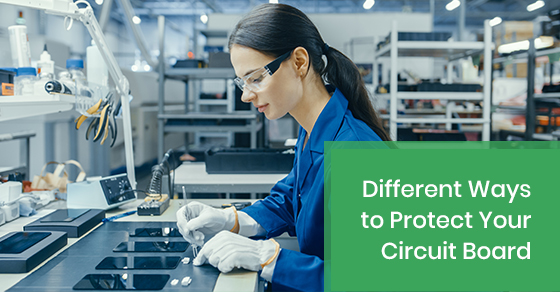Conformal Coating: Different Ways to Protect Your Circuit Board
Electronics are featured in many different environments thanks to the rise of various technology forms, including the Internet of Things (IoT). Many electronic connections are sensitive, though, and maybe vulnerable to dust, moisture, high temperatures, and other hazards. Such hazards can damage certain components and may even impact the integrity of the assembly as well.
Fortunately, there exists a process called conformal coating, and there are many different types to choose from. A thin transparent film should be applied directly to your circuit board. The film will contour to the circuit board's shape and protect all of its valuable components in the process.
Here, we will discuss the different types of the conformal coating so that you can decide which will work best for your circuit board.
The Brush Method
If you are dealing with a low-volume production run, you can simply use the brush method, a simple application. It also works very well for low-volume repairs and reworks. The brush method is not pleasing aesthetically, but it tends to be thicker and performed manually.
If you are working on only a few circuit boards at a time and/or simply don’t have the tools needed to explore other options, we recommend this approach.
The Spray Method
You will need to use an aerosol spray to apply the coating to your circuit board for this method. We also recommend the spray approach for low-volume production runs, but it does have a few drawbacks.
For example, it can be quite time consuming, as you will need to mask all of the areas that do not need to be coated. It also does not provide deep penetration of the circuit board. Still, it is quite cost-effective and does offer a superior surface finish.
The Dipping Method
Here, you will need to submerge the circuit board in a coating solution before extracting it. The dipping method works quite well for high-volume production runs. The board is also completely penetrated via this approach, and it provides accurate and fast results.
However, the masking will need to be pitch-perfect, as failure to do so will lead to leakage. The dipping method will cover the entirety of the assembly, which is a significant advantage. However, subpar masking will make most circuit boards unsuitable due to the design process. Note, as well, that this method will only work for circuit boards that accept coating on both sides.
The Selective Coating Method
In order to make use of the selective coating method, you will need automated robotic spray nozzles. They will apply the conformal coating to certain areas of the assembly.
As you may suspect, the selective coating method works best for high-volume production runs. It is a fast and very accurate approach that applies conformal coating directly to the required areas. Due to its direct coating benefits, no masking is needed. Also, the board will need to be configured or designed to make it compatible with this method.
Acrylic Resin (AR): Pros and Cons
The drying process is quite easy, as is reworking. AR provides a solid amount of resistance to humidity. It boasts a high fluorescence level, and viscosity can also be adjusted with relative ease.
However, trying to maintain viscosity may prove to be difficult with this approach. Another issue with AR is that it is quite flammable, which makes it a fire hazard. The probability of reversion is also quite high, especially if humidity and/or temperature stress are involved.
Epoxy: Pros and Cons
Epoxy offers solid humidity resistance, as well as adequate dielectric properties. It is quite useful to around 302℉, or 150℃. As well, the CTE is closer to the epoxy printed circuit board substrate, which is beneficial. Epoxy also boasts superb resistance against abrasion, as well as most chemicals.
However, this method does have a few drawbacks. For instance, it lacks flexibility and involves complicated mix ratios. It is difficult to rework, and the risk of chloride contamination is elevated. Maintaining optimal viscosity may also prove difficult, as epoxy is quite process-intensive.
The potential for high stress is yet another issue, especially during temperature-cycling conditions. Epoxy is also quite hard to remove, and the probability of reversion is high under humidity and temperature stress.
Urethane Resin (UR): Pros and Cons
UR is solvent resistant, and its reversion potential is lower than that of epoxy. It is also resistant against abrasion and provides good resistance against moisture. Its dielectric properties are quite good. However, the time it takes to cure completely is long, as it may take up to 30 days. Moisture may also negatively impact many of its desired properties, as well as its cure rate.
UR does bring up certain safety and health concerns, and the probability of reversion is high when exposed to humidity and temperature stress. The potential for elevated stress is also an issue during temperature-cycling conditions.
Silicone Resin (SR): Pros and Cons
SR boasts very high dielectric strength. Its abrasion and moisture resistance levels are adequate. It also boasts low-surface energy levels, which allows for effective penetration under the components.
Its resistance to UV and humidity are quite high. It also provides impact and dampening protection, as SR is very flexible. It has proven itself to be stable over a wide temperature range as well.
As for the cons, it does not provide protection against solvent vapours or solvents, and it has a brief pot life. Cross-contamination is a possibility if superlative housekeeping is not adhered to. It also requires a minimum of 20% RH to cure, so humidity is a must.
Circuits Central
If you would like to learn more about conformal coating in Toronto or require conformal coating for your projects, then please visit Circuits Central on our website.

